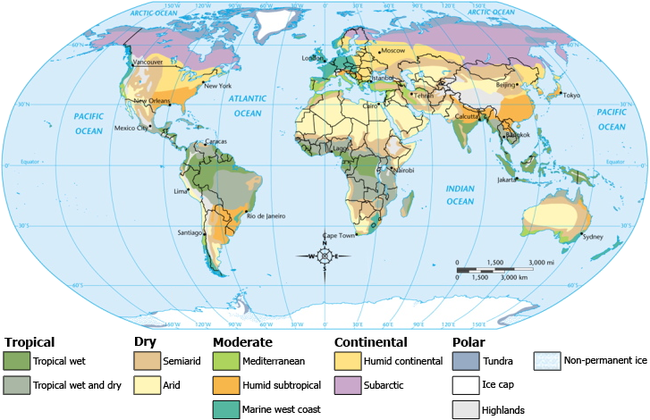Climate
Climate is broadly defined as the long-term statistics or characteristics of weather that are determined over time.[1] These can be any characteristics, ranging from the average expected weather patterns to the measure of the variability and likelihood of extreme events. Statistics that are used to define the climate of a region, shown in Figure 1, or the climate of the planet as a whole, can be performed on any variable that helps characterize the behavior of the environment; the atmosphere, ocean, sea ice/snow properties, etc. These include but are not limited to temperature, precipitation, humidity, wind speed, sea level pressure, ocean salinity, or various flows of energy into and out of the planet.

Understanding Climate
Long-term statistics are performed on meteorological data in order to understand the typical range of behavior we expect in some location, in addition to the normal conditions around which that atmospheric variability occurs.[1] For instance, Florida's climate is hotter and moister than that of New York or Quebec, even if individual days occur when this is not the case. Additionally, things like the seasonality (e.g., changes from summer to winter), change from day to night, occurrence (or lack of) monsoon systems in certain regions, or the presence of interannual variability (e.g., floods and droughts) are not examples of climate change - rather, they are defining characteristics of the prevailing climate experienced in certain parts of the world.
Generating a robust statistical description of the climate system generally requires at least several decades of data. The classical period of time is 30 years, as defined by the World Meteorological Organization (WMO),[3] but an appropriate time period over which to sample the range of internal variability will depend on the metric of interest. Therefore, changes in climate are typically defined by changes in these long-term statistics over many decades to centuries.[1]
Climate Systems
- For a more in depth look please visit the page: Climate system.
The climate system on Earth includes several sub-components, all of which may influence each other and effect (as well as be effected by) climate:
- Atmosphere: the gaseous envelope that enshrouds the solid planet, and is important for mediating the flow of energy into and out of the planet, and for dynamic transports of mass, energy, momentum.
- Hydrosphere: this includes the collective mass of water on the planet and the fluxes of water between different components of the climate system.
- Cryosphere: This includes all of the "frozen" components of the hydrosphere, i.e., the snow and ice on the planet.
- Biosphere: The biological (living) component of the Earth system, including the global sum of ecosystems and biodiversity.
- Land surface: The land surface of the planet, the solid surface upon which much of the biosphere resides and where exchanges of energy associated with other climate sub-components occur.
The climates of other planets may lack one or more of these "spheres." Typically, an atmosphere is the only sufficient condition to sensibly define the existence of a "climate", although all of these components are essential for understanding and describing Earth's climate and any interactions occurring between them.
For Further Reading
- Climate change
- Climate forcing
- Climate vs weather
- Global warming
- Atmosphere
- Or explore a random page
References
- ↑ 1.0 1.1 1.2 Charron, I. (2016). Guidebook on Climate Scenarios: Using Climate Information to Guide Adaptation Research and Decisions. [PDF] Ouranos, p.7. Available at: https://www.ouranos.ca/publication-scientifique/Guidebook-2016.pdf [Accessed 24 Feb. 2020].
- ↑ Wikimedia Commons [Online], Available: http://upload.wikimedia.org/wikipedia/commons/d/df/ClimateMap_World.png
- ↑ WMO, Statistical depictions of climate [Online], Available: https://www.wmo.int/pages/themes/climate/statistical_depictions_of_climate.php

